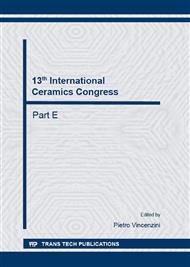p.82
p.88
p.94
p.100
p.108
p.117
p.123
p.134
p.140
Influence of Application Technology in the Structural Characteristics of Ceramic Coatings with Advanced Anticorrosive and Tribological Properties
Abstract:
Electrophoretic deposition (EPD) of ceramic frits is shown to be a useful coating method for different metal surfaces and geometries since it allows obtaining very smooth surface finishes with precise control of their thickness. By the other hand, these kind of coatings show differences with the coatings obtained by conventional wet application methods as dipping, flow-coating, slushing and spraying. At this point, CIDETEC has used an own advanced ceramic coating based on no commercial enamels to determinate the best application method to obtain an excellent anticorrosive coating on carbon steel. In view of possible scaling up to particular industrial applications, a detailed characterization of the microstructure, morphology, physical, chemical and mechanical properties of the coatings was performed. The preliminary studies show that EPD system improves the characteristics of this coating.
Info:
Periodical:
Pages:
108-116
Citation:
Online since:
October 2014
Authors:
Price:
Сopyright:
© 2014 Trans Tech Publications Ltd. All Rights Reserved
Share:
Citation:


